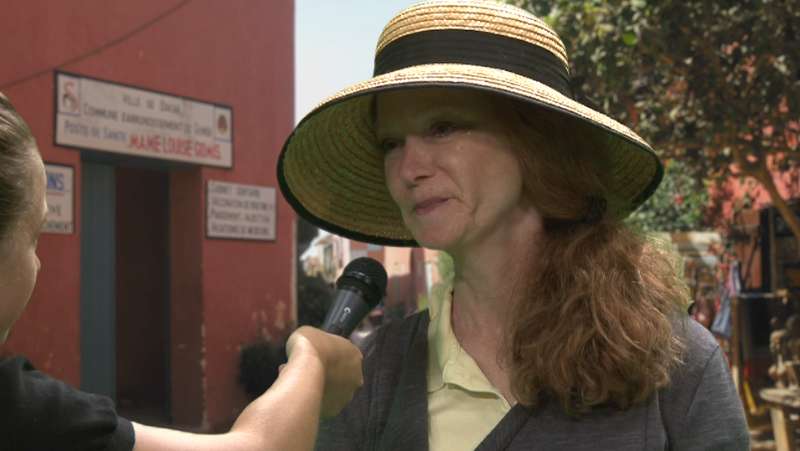The Brief Global Health Backstory of the Game

(Mary Werick as Nina Novus Scriptor, intrepid reporter...)
Early Game Design Thoughts
The heavy-travel involved in the work of a global public health practitioner served as a core inspiration for the "Where in the World is Dr. Salus "Dynamica" Mundi?" game, which was built to focus on the interconnected and global nature of international public health. While information and communications technologies (ICT) are integrated and so critical to global public health, so much of the work has to be done person-to-person and in an on-ground location-based way. The play would be true to the medical science and culture as much as possible. The global aspects of this course lent itself to the idea of a geographically based game--as a structure on which to hang the ideas. The actual play would be light. The focus would be on making the game as accessible as possible to as wide an audience as possible. The game is not part of the global health course; rather, this is a value-added add-on as a culmination of the course design.
Other alternative structures? Certainly, there may be other ways to frame a game. There may be an unfolding scenario of an unknown disease unfolding. There may be a natural disaster and its aftermath. There may be a detailed preparation for a team going into a particular village with various needs. There may be a purely science-based adventure in a laboratory with an unknown pathogen with a pathogen hunter. The possibilities are numerous. As with most design situations, we went with what we could achieve given the budget, time, technology, and other limits.
Awareness of real-world sensitivities. Then, given the political sensitivities of various potential depictions, it was decided that separating the fictional game from the real-time exploits of the principal investigator (PI) and professor of the Global Health course would be critical to the success of the course, the game, and the continuing professional work of Dr. Deborah J. Briggs. There would be a conscious avoidance to separate the fictional game reality from the real-world one. The science, though, should be accurate, so there is no accidental "negative learning" (inaccurate, unintended learning) from the playing of the game. We would emphasize this point with a disclaimer—not to be legalistic but rather to not accidentally impugn anyone with the storylines. This "backstory" piece is a kind of debriefing of the game history.
Takeaway Concepts
While the team decided not to use real-world cases with a fictional character, they realized that it would be critical to highlight some basic tenets of global public health. These themes would infuse the mystery cases, and they would add some pedagogical value to the game. These concepts were drafted out in the early documents of the game design to serve as guiding principles.
- First, do no harm. A lot of care goes into global health to make sure that endeavors undertaken are health-promoting, sensitive to local cultures and ideas, and optimally, sustainable. Endeavors may have intended and unintended consequences, and much analysis goes into such potential effects.
- Complex environmental factors. The public health interventions are designed to deal with complex situations, with public health affected by economics, politics, culture, science, human behaviors, and a range of other factors.
- Strategic partnering: The complexity of global public health may be seen in part by the various partnerships involved. Global public health is a community affair. Various partners include governments, non-governmental organizations, people groups, pharmaceutical companies, insurance companies, health care workers, epidemiologists, food scientists, law enforcement, and others. These various stakeholders all have critical roles to play. In this highly competitive field, there may be various types of personality strife. The nemesis has to be poverty and diseases, never other people.
- Public education and training. At one level, public health involves individual decisions made at the ground. Decisions made that become habits can affect overall health of the individual—such as decisions to consume alcohol, illicit drugs, high-fat and high-caloric foods, and to smoke cigarettes. There are certain modes of disease transmission that will be important for people to know to head off potential pandemics. The public has to be informed and empowered at the local levels to make the choices that will benefit their own lives. It would be important to show the importance of education and training to get a population engaged. It is also important to show the need for near-continuous learning by the global public health individual. It would be important to get information about working with different people groups in a respectful way.
- Global surveillance and early notification: Global public health requires early notification of emergent diseases and of potential pandemics—through accurate global surveillance, rigorous lab testing, and epidemiological work. Early information will allow for expert consultations and whole response packages. It will enable a rallying of the global health networks (both formal and informal) to rally a response that may head-off the potential spread of dangerous pathogens.
- Concept of baseline health and resilience: The concept of having basic health (appropriate nutrition, maternal care, early childhood nutrition and care, sanitation and hygiene systems, strong governance, and appropriate educational systems) and basic public health structures and communications systems in place strengthen the resilience of a society against health challenges—whether these challenges are naturally occurring or human-made or a combination of those causal factors. There needs to be expertise in the community to ensure that the proper help comes at the right time. There are definitely "one health" issues at play. The needs of animals are also important for overall health because of zoonotic diseases. Global public health involves creating expansions of capacities and functions.
- Sustainable critical Infrastructures: The focus on national security in the US has led to a definition of critical infrastructures and global manufacturing chains that affect public health. It would help to show how these take years to design and build over time. These are often a result of smart planning and the overall resources and leadership of a society. Whatever global public health structures are put into place have to be sustainable into the long term.
- Basic health science: It helps to look at the scientific underpinnings of public health. Some assumptions of public health involve understandings of disease and disease transmission. There are a number of dependencies in the understandings of what leads to public health.
- Technological surveillance and interventions: Information and communication technology (ICT) inform and affect global public health. It will be important to bring in data-rich approaches. Further, the game characters should all be wired in and wired up, to encourage the uses of various public health ICT resources and technologies.
Creating a mystery. The game had to be an automated one because that would make it easier to deliver and more scalable. Another design option was to potentially add an interactive discussion element, such as a Twitter feed or a wiki that participants could contribute to. Given the lack of general audience knowledge of global public health, it seemed that a mystery based on geography might be more doable than any sort of a science-based medical mystery. We were using the framework of a game to inspire readers—not to test their global public health knowledge per se.The plan was to have the global health heroine leave clues with electronic snippets of information, with her packing, with her foreign exchange currency, her transportation, the localized health issues, and other information. This game concept borrowed lightly from a popular game that was turned into a television series that focused on the learning of geography.
Essentially, each game scenario would consist of a basic fictional case (using text and multimedia), a video with clues, a map with the question of where the doctor could be, and then decision-making—with results. There would be a debriefing summary at the end with possibly some light teaching points about global public health. These scenarios would be strung together with clues from one case to the next. In the intermittent locations, if caught up with, the doctor would offer some clue. There might be a "reward" of seeing the doctor in a particular situation or in particular local garb. All the locations where she is found will be different from each other. Ultimately, the elusive doctor would be caught up with and would share some profound information about global public health.
The limits of the technology coding. In any technology-based build, the development team works against the limits of the technologies and their own imaginations. For our situation, we had limited authoring tool technologies to achieve any sort of simulations—so the game itself could only be evoked with a limited set of interactions and details. The green screen chroma key aspect of videography was brought into play in order to be able to use a video snippet of the elusive doctor again and again—with different background images of various locales from around the world. While there was access to some original raw materials, we would mostly have to use open-source contents and whatever our minds could afford. Some of the technologies considered have been integrated here. The development team also wanted this all to be mobile accessible, which would mean limited uses of Flash technologies.
Character ideas.The development team struggled to find a name for their main character without using anything that already existed in the world. They decided to go with a Latinate underpinning, and they came up with Dr. Salus "Dynamica" Mundi (Dr. Health Dynamic World). This name would indicate her role but would also show how health links with the dynamism of a life. People who suffer various diseases experience devastating effects on their livelihoods, with many unable to earn a sufficient living because of health challenges. In her work travels, she would model safe and healthy travel, with respect for those with whom she comes into contact. The elusive global health doctor would be chased by a young reporter, Nina "Novus" Scriptor (aka Nina the New Writer). (For those who care, a variety of names were considered for the doctor. The English versions sounded cornier than the Latin forms: Dr. Infirmorum Liber, Dr. Sapientia Sanitas, Dr. Morbi Exstirpatione, Dr. Morbo Liber, and Dr. Salutem. The reporter's family name could have been any of the following: Testimonium, Testis; Discipulus, Alumno; and Secuutus.)
Game scalability. The game is a kind of automated learning. There is no human oversight to the play. The gameplay is not tracked. The playability then depends on the server load of all individuals accessing the game at a particular time.
The resources used for building the game. The game drew heavily on extant resources provided foremost by the subject matter expert (SME), Dr. Deborah J. Briggs. It also drew from the curriculum and the work done to achieve understandings, to set up a diversity of scenarios.
Assessing the game. This game was created to help general readers access some of the basic concepts of global public health. There is not a formal assessment currently to test some of the learning in the game. If one were to be created, it would draw on the main global health principles here.

(Dr. Deborah J. Briggs as Dr. Salus 'Dynamica' Mundi...)
